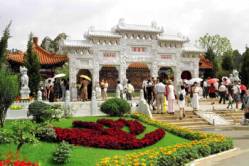|
|
|
OPENING
TO THE OUTSIDE WORLD
|
|
Special
Economic Zones and Open Coastal Cities
When it decided to reform the
national economic setup in 1978, the Chinese government embarked
on a policy of opening to the outside world in a planned way and
step by step. Since 1980, China has established special economic
zones in Shenzhen, Zhuhai and Shantou in Guangdong Province and
Xiamen in Fujian Province, and designated the entire province of
Hainan a special economic zone. In 1984, China further opened
14 coastal cities??Dalian, Qinhuangdao, Tianjin, Yantai, Qingdao,
Lianyungang, Nantong, Shanghai, Ningbo, Wenzhou, Fuzhou, Guangzhou,
Zhanjiang and Beihai??to overseas investment. Then, beginning in
1985, the state decided to expand the open coastal areas, extending
the open economic zones of the Yangtze River Delta, Pearl River
|

China's
'99 Kunming World Horticultural expo was opened on April 30. This
picture shows a scene built by Shandong Province.
|
|
Delta, Xiamen-Zhangzhou-Quanzhou
Triangle in south Fujian, Shandong Peninsula, Liaodong Peninsula,
Hebei and Guangxi into an open coastal belt.In 1990, the Chinese
government decided to open the Pudong New Zone in Shanghai to overseas
investment, and opened more cities in the Yangtze River valley.
In this way, a chain of open cities extending up the Yangtze River
valley, with Shanghai??s Pudong as the ??dragon head,?? has been formed.
Since 1992, the State Council has opened a number of border cities,
and in addition, opened all the capital cities of inland provinces
and autonomous regions. In addition, 15 free trade zones, 32 state-level
economic and technological development zones, and 53 new- and high-tech
industrial development zones have been established in large and
medium-sized cities. As a result, a multi-level, multi-channel,
omni-directional and diversified pattern of opening, integrating
coastal areas with riverine, border and inland areas has been formed
in China. As these open areas adopt different preferential policies,
they play the dual roles of ??Windows?? in developing the foreign-oriented
economy, generating foreign exchanges through exporting products
and importing advanced technologies and of ??radiators?? in accelerating
inland economic development.
Primarily geared to exporting
processed goods, the five special economic zones are foreign-oriented
areas which integrate science and industry with trade, and benefit
from preferential policies and special managerial systems. They
have summed up their rich experiences in absorbing foreign investment
and developing foreign trade for China to open up to the international
market. In recent years, the special economic zones have led the
country in establishing new systems, upgrading industries and opening
wider to the outside world, serving as national models. In 1999,
Shenzhen??s new-and high-tech industry became one with best prospects,
and the output value of new-and high-teach products reached 81.98
billion yuan, making up 40.5 percent of the city??s total industrial
output value and coming out in front in the country.
Since its founding in
1992, the Shanghai Pudong New Zone has made great progress in both
absorbing foreign capital and accelerating the economic development
of the Yangtze River valley. The state has extended special preferential
policies to the Pudong New Zone that are not yet enjoyed by the special
economic zones. For instance, in addition to the preferential policies
of reducing or eliminating Customs duties and income tax, common to
the economic and technological development zones and certain special
economic zones, the state also permits the zone to allow foreign business
people to open financial institutions, and run tertiary industries.
In addition, the state has given Shanghai permission to set up a stock
exchange, expand its examination and approval authority over investments
and allow foreign-funded banks to engage in RMB business. In 1999,
the GDP of the Pudong New Zone came to 80 billion yuan, and the total
industrial output value, 145 billion yuan. Up to now, 78 Chinese and
foreign-funded financial institutions have been set up in Lujiazui,
Pudong, of which 24 foreign-funded banks have been approved to engage
in RMB business. The 5,900 foreign-funded enterprises, with a total
investment of nearly US$30 billion, and over 5000 domestic enterprises
from all over the country, with a total registered capital of about
20 billion yuan, have formed six pillar industries: automobiles and
spare parts and components, microelectronics and computers, household
electrical appliances, bio-medicines, and optical, mechanical and
electrical products. A large number of projects funded by business
people from more than 60 countries and regions have taken root and
blossomed there. Pudong??s ??dragon-head?? role of radiating and leading
the whole country is becoming more and more prominent. |
|



